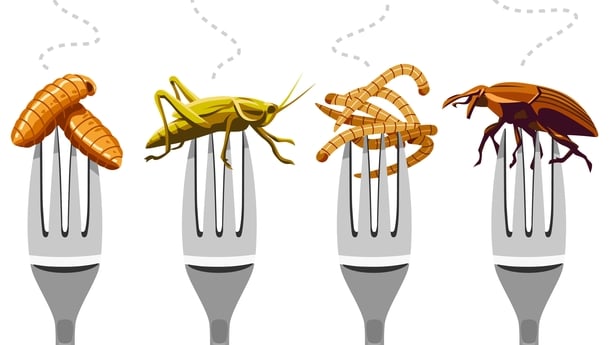Terry: "Eating insects".

Waiter, waiter, there's NO fly in my soup!
The human population has increased dramatically over the last 100 years. There are now approx. 8 billion humans on Earth. Over 1 billion are officially designated as being hungry.One in seven people on Earth are undernourished!
There are a number of reasons for this including the current economic crisis and the significant rise in food prices in recent years. So what can be done?
Eating insects might be one solution!
Eating insects is not new to us, nor is it rare. Today, insects are eaten intentionally by humans, in approximately 100 countries! The ancient Romans and Greeks dined on insects. The Roman scholar, Pliny and the Greek philosopher, Aristotle wrote on the subject and the Old Testament encouraged Christians and Jews to consume locusts, beetles and grasshoppers. St. John the Baptist is said to have survived on locusts and honey when he lived in the desert. We are not familiar with the practice because it is not the norm in Europe or in the United States. However, most people in tropical countries are used to having insects on the menu.
A recent UN conference promoted the eating of insects for everyone from famine victims to astronauts. Scientists there stated that crickets, caterpillars and grubs could be an important food source during droughts and other emergencies.
So what are the advantages of eating bugs?
They are high in protein, require less space to grow and provide a more environmentally friendly alternative to the farm animals we now depend on. Insects produce less methane, nitrous oxide and ammonia per unit body of mass than either cattle or pigs. Insects can therefore be a more efficient source of protein.
Hamburger, for example is about 18% protein and 18% fat. Cooked grasshopper, meanwhile, contains up to 60% protein with just 6% fat. Moreover, like fish, insect fat is unsaturated and therefore healthier.
Insect farming is much more efficient that cattle production. 45 Kilos of feed produces 4.5 kilos of beef while the same amount of feed yields 20 Kilos of crickets. Essentially, insects convert carbohydrate into protein and we can influence the taste of insects a lot by providing them with different types of food. As long as you have a balanced diet, then it doesn't matter whether the protein comes from a cow or a cricket.
A United Nations report in 2006 stated that livestock production was responsible for 18% of global greenhouse gas emissions (that’s more than what is produced by transportation worldwide!). And the problem is expected to double within the next 40 years or so.
So why are we against eating insects?
Since we became farmers and decided to raise crops and keep livestock, insects were seen as destroyers of these crops and livestock, rather than as a source of food. Insects were our enemy. Also, lots of people have a fear of insects. They see them as alien looking creatures that must be exterminated. However, we do not have a problem eating crab, lobster or crayfish. Although they are not insects, they are closely related Crustaceans and worse still, they are the scavengers of the oceans.
Types of edible bugs:
Approximately 2,000 different species of insects are already eaten by humans. Grasshoppers, beetles, ants, crickets, silkworms, termites and mealworms are just the tip of the iceberg. They can be eaten raw or cooked. Cooked in soy sauce and sugar, zaza-mushi – the larvae of aquatic caddis is a delicacy in rural Japanese towns.
We are already eating insects (without knowing it). The United States’ Food and Drug Administration (FDA) has permitted certain levels of insects to be found in food products. In the United States, the allowable amounts of insect per 100 g of processed food products are as follow: 80 insect fragments for chocolate, 60 aphids or mites for frozen broccoli, 100 insect fragments for macaroni and other noodle products, 60 insect fragments for peanut butter and 150 insect fragments for wheat flour.
How can we convert Americans and Europeans to eat insects?
If we are convert humans to eat insects, we will need to market them properly. Get an international star (a famous footballer, pop singer or actor) to endorse them. But will it happen? Probably not. There is however, other ways in which insects may be made use of. Animal and fish foods are becoming more and more expensive. Instead of conventional foods, it may be possible to use insects as a source of fish and animal food. To overcome the stigma of eating insects, it may be possible to process them into some sort of protein product similar to tofu. If insects were processed into something unrecognizable this might make them more acceptable. And finally, they could be coated in something else (chocolate) to disguise the taste and crunching sound as you eat them.
Whatever happens, the day may soon be upon us when we are demanding to know why there is NO fly in soup on a night out!
